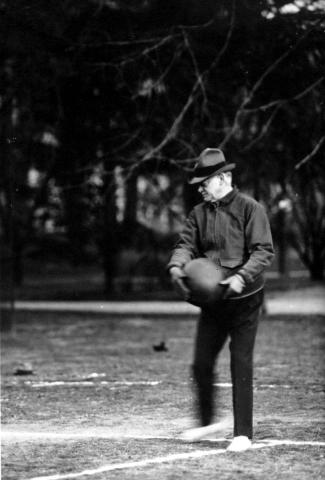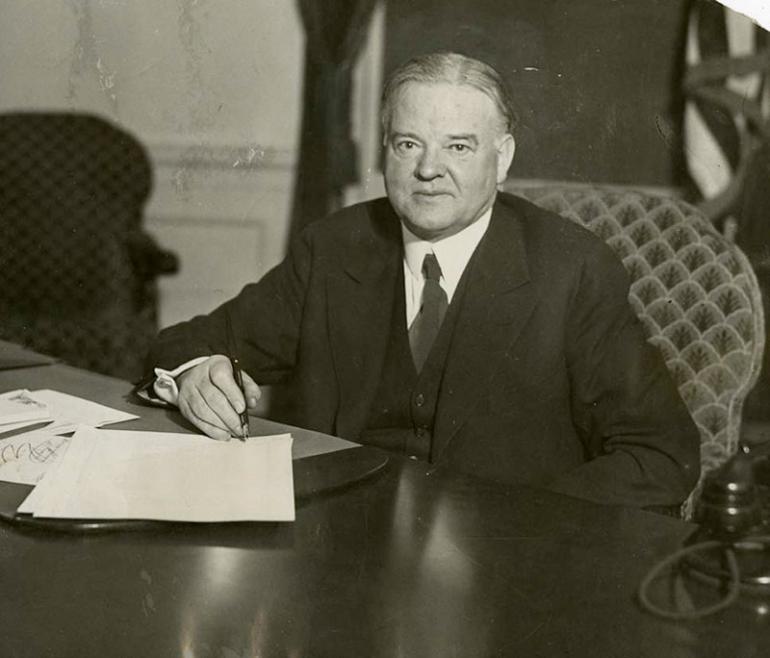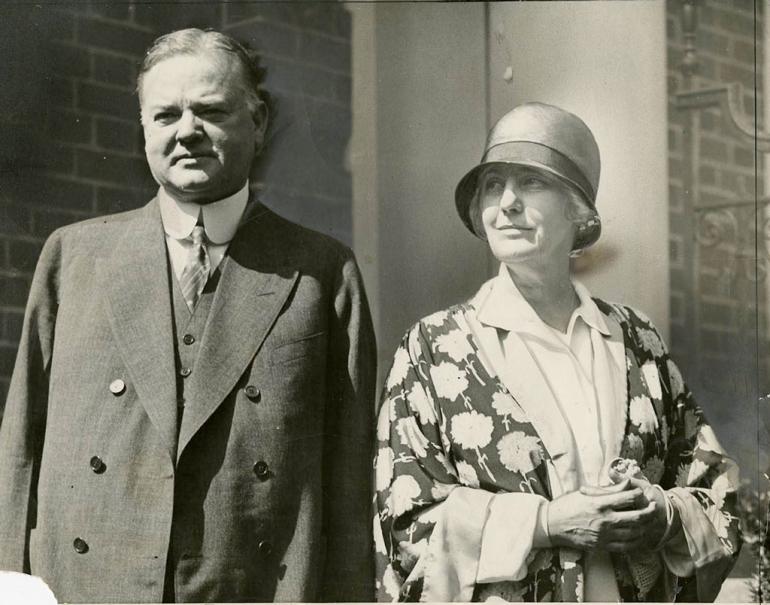On This Page
- Rendering Links ...
History of Hoover-Ball
History of Hoover-Ball

Hoover-ball is a combination of tennis, volleyball, and medicine ball. White House physician Adm. Joel T. Boone invented the game to keep President Hoover physically fit.
"It required less skill than tennis, was faster and more vigorous, and therefore gave more exercise in a short time," Hoover wrote in his memoirs.
"It is more strenuous than either boxing, wrestling or football," wrote Will Irwin, a friend of Hoover's, in a 1931 article "The President Watches His Waistline" in Physical Culture magazine. "It has the virtue of getting at nearly every muscle in the body."
The sport was without a name until New York Times Magazine reporter William Atherton DuPuy christened the game "Hoover-ball" for his 1931 article "At the White House at 7 a.m."
Hoover-ball was played by teams of two to four players with a six-pound medicine ball over a net eight feet high on a court similar to one used for tennis. The game was scored exactly like tennis, and played in a similar fashion. The server throws the ball. The opponent must catch it on the fly and immediately return it, attempting to put it where it cannot be reached and returned. The side that misses the ball or throws it out of bounds loses the point.
"Stopping a six-pound ball with steam back of it, returning it with similar steam, is not pink-tea stuff," DuPuy wrote. "Dr. Boone estimates that as much beneficial exercise is obtained from half an hour of it (Hoover-ball) as from three times as much tennis or six times as much golf."
The sport originated in 1928, when shortly after his election Hoover took a goodwill trip to South America. While aboard the battleship Utah on his return, he watched a game of bull-in-the-ring, a medicine-ball game that was popular on naval ships. A soft nine-pound medicine ball was thrown from one to another of the players standing in a circle as the "bull" in the center tried to intercept it. During the trip, the President-elect played and enjoyed the game, which was the inspiration for Hoover-ball.
"Getting daily exercise to keep physically fit is always a problem for Presidents," Hoover wrote. "Once the day's work starts there is little chance to walk, to ride or to take part in a game. Taking walks or rides early in the morning is a lonesome business, and the inevitable secret service guard when the president leaves the White House grounds is not enlivening company."
Hoover and Dr. Boone then hit upon the idea of morning medicine ball workouts. Dr. Boone adapted bull-in-the-ring to Hoover-ball to help the President slim down. Four days after Hoover's inauguration, the games began. The players experimented with medicine balls of different weights (the nine-pound used for bull-in-the-ring was too heavy) and with the net at different heights before finalizing the Hoover-ball rules.
Early each morning, between 4 and 18 VIPs would show up for the games on the south lawn of the White House. The participants soon became known as the Medicine Ball Cabinet, although not all were official Cabinet members.
"At seven o'clock sharp they choose partners and begin," Irwin wrote. "A factory down by the Potomac blows a loud whistle at seven-thirty. This is the signal to quit, no matter how close the score; for the business of governing must go on."
Only once did Hoover cancel a game; that was when he arose early to write a message to deliver to the Senate that day.
"Except for Sundays, we played medicine ball every morning of the week, including official holidays," Secretary of the Interior Ray Lyman Wilbur wrote in his memoirs. "Only absence from Washington kept us away."
"We paid no attention to the weather except for a very heavy rain," Wilbur recalled. We played in cold and wind, snow and rain, and in the four years we were driven indoors only two or three times, because of an unusually drenching downpour."
On those rare occasions when they were forced inside, the Medicine Ball Cabinet retreated to the White House basement to play the game.
Every year in August the Hoover Presidential Foundation hosts the Hoover-Ball National Championship games.
Rules that President Hoover Played With
- The court is 66 feet by 30 feet.
- A 6-pound medicine ball and 8-foot vollyball net are used.
- Teams consist of 2–4 players. (For the national championships, 3-player teams will be used.) Each team may have one or two subsitutes.
- Scoring is exactly like tennis. Teams play best-of-five or best-of-seven games.
- Points are scored when a team: fails to catch the return, fails to return the ball across the net, returns the ball out of bounds.
- The ball is served from the back line. The serve is rotated among one team until the game is won. Teams alternate serving after each game.
- The ball must be caught on the fly and immediately returned from the point it was caught. There is no running with the ball or passing to teammates.
- Each team's court is divided in half. A ball returned from the front half of your court must be returned to the back half of your opponent's court. If the ball doesn't reach the back court, the opponent is awarded the point.
- A ball that hits the out-of-bounds line is a good return.
- A player who catches the ballout-of-bounds, or is carried out-of-bounds by the force of the ball, may return in-bounds before the return.
- A ball that hits the net on its way over is a live ball. (If it was thrown from the front court, it must reach the opponent's back court to be good.)
- Teams may substitute at dead ball situations.
- Women serve from the mid-court line.
- Women may pass once before a return.
- Women may return the ball to any area of the opponent's court.
- Good sportsmanship is required. Points in dispute are played over.


